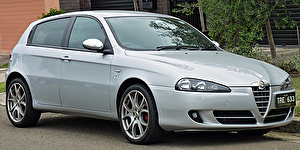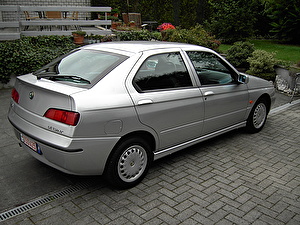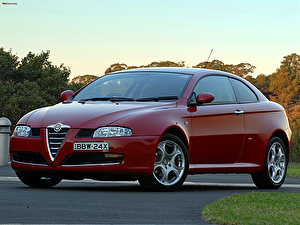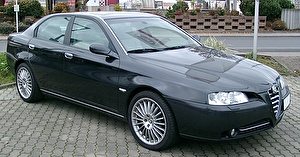Шины и диски для автомобиля Alfa Romeo

Подбор шин и дисков по автомобилю Альфа Ромео
- 1
- 145 111995-2001
- 146 201995-2001
- 147 132000-2010
- 155 111992-1997
- 156 281997-2007
- 159 192005-2011
- 164 131987-1998
- 166 181998-2007
- 3
- 33 151983-1995
- 4
- 4C 12013-2020
- 7
- 75 151985-1992
- 8
- 8C Competizione 12007-2011
- 9
- 90 71984-1988
- A
- Alfa 6 41979-1986
- Alfasud 51972-1989
- Alfetta 61972-1987
- Arna 41983-1987
- B
- Brera 112005-2010
- C
- Crosswagon Q4 12004-2007
- G
- Giulia 271962-19782015-2024
- Giulietta 281977-19852010-2021
Наиболее популярные модели Alfa Romeo
Диски на Альфа Ромео
- PCD 4x108 диаметром от 14 до 14, шириной от 5 до 5.5 и профилем от ET22 до ET38 как у Ford Fiesta
- PCD 5x108 диаметром от 16 до 16, шириной от 6.5 до 7 и профилем от ET35 до ET41 как у Zotye T500
- PCD 5x110 диаметром от 16 до 19, шириной от 7 до 10 и профилем от ET25 до ET41 как у Opel Zafira
Шины на Alfa Romeo
- Размерность шин от R13 до R21, шириной от 145 до 285 и профилем от 30 до 80
- Минимальный размер резины: 145/80 R13, максимальный: 235/65 R17
Любимые зимние шины
Наиболее популярные модели шин
Шины на Alfa Romeo (Альфа Ромео)
Итальянская компания Alfa Romeo была создана французом Александром Дарраком 24 июня 1910 года в Милане. Помимо него в создании всемирно известного автопроизводителя приняли участие итальянские инженеры Никола Ромео и Уго Стелла. Практически сразу после своего создания компания уделила много внимания автогонкам. Уже в 1911 году первые Alfa Romeo приняли участие в соревнованиях на двух моделях 24 HP. В дальнейшем автомобили этой марки принимали участие во всех значимых автомобильных гоночных состязаниях и чемпионатах, начиная от Гран-При Формула-1 и заканчивая ралли. Кроме того, Alfa Romeo была представлена в качестве технического партнера огромного количества гоночных команд, в частности, поставляя для их болидов двигатели. И именно эта марка стояла у истоков создания Scuderia Ferrari. До 1939 года это была Alfa Romeo.Развитие
В 1932 году компания вошла в состав государственного холдинга IRI, где она пребывала вплоть до середины 80-х годов прошлого столетия, преодолевая один за другим финансовые кризисы. Наибольшие проблемы с популярностью марка испытала в 1980-е. Несмотря на все усилия и коммерческий успех модели Alfa Romeo 75, компании пришлось пойти на поглощение более крупным автопроизводителем, которым стал FIAT.Инновации
За время своего существования компания представила большое количество собственных технологических инноваций. Значительная их часть приходится на двигатели. Например, еще в 1914 году Alfa Romeo представила силовой агрегат с двумя распределительными валами и головкой блока цилиндров. В массовое производство этот мотор пошел в 1928 году, по-прежнему являясь одним из самых технологически совершенных изделий для того времени. Еще одним важным нововведением является первая в мире полностью электрическая инжекторная система подачи топлива. В 1940 году такой двигатель появился в гоночном автомобиле Alfa Romeo 6C 2500. Также стоит отметить наличие в портфолио компании первый в мире легковой автомобиль с дизельным двигателем, оснащенным топливной системой Common Rail, сегодня являющейся отраслевым стандартом.Оригинальный дизайн
Помимо двигателей автомобили Alfa Romeo являются обладателями эффектного облика. В разное время разработкой дизайна занимались такие компании, как Bertone, Ital Design, Pininfarina и Zagato. При этом помимо внешнего вида многие решения в этой области были технически эффективными и не раз копировались другими автомобильными производителями. Прежде всего, это аэродинамика. В 1960-е года компания предлагала модель Guilia с низким коэффициентом аэродинамического сопротивления. После ее появления Toyota попыталась воспроизвести эту технологию, выпустив целую линейку моделей. В 1980-е годы итальянский производитель перешел на полностью компьютерную разработку автомобилей и производство с минимальным участием человека. Это оказало заметное влияние на дизайн, в котором появилось много сложных форм. Первой такой моделью стала Alfa Romeo 164, после появления которой многие производители также перешли на компьютерное проектирование и автоматизированное производство.Преимущества подбора шин на Alfa Romeo на нашем сайте
- большое количество моделей покрышек для легковых автомобилей и кроссоверов итальянского бренда;- характеристики шин полностью соответствуют эксплуатационным свойствам самых мощных автомобилей Alfa Romeo;
- возможность подобрать покрышки, как от ведущих производителей автомобильных шин, так аналогичные изделия менее известных брендов с сопоставимыми свойствами;
- простота выбора благодаря автоматизированной системе подбора, не требующей технических познаний в данной области.





















